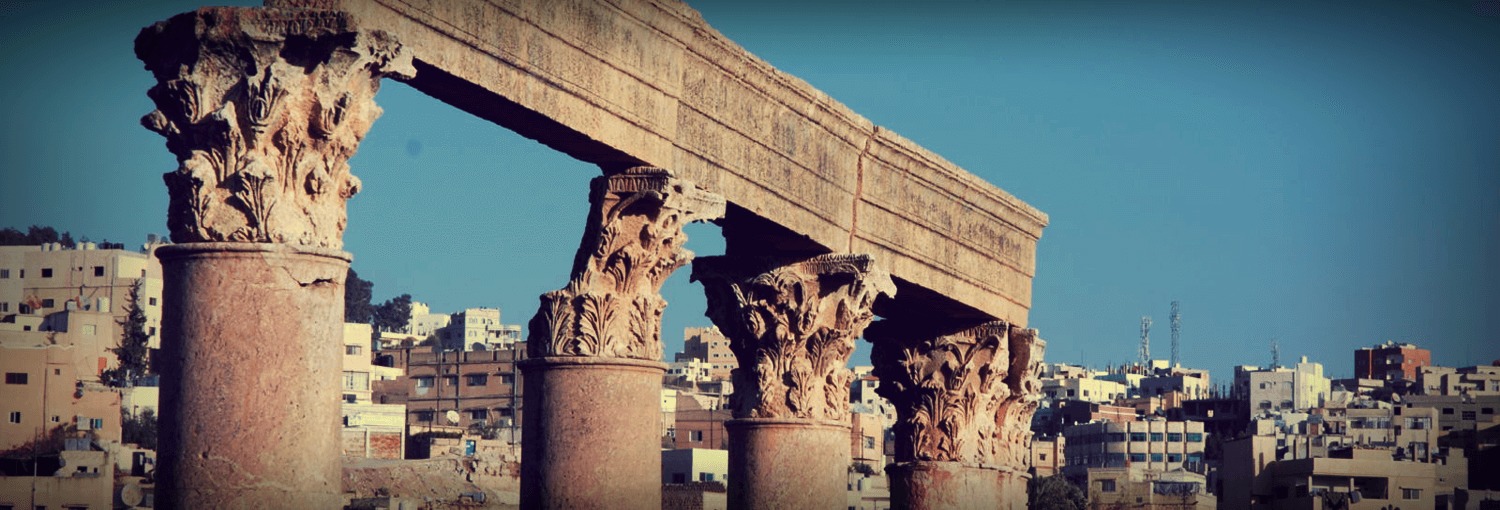
TEMPLE OF ARTEMIS 2018-2020
The 2019 Jerash Visitors Study
by Anna Paterlini
A short, target study of the tourists was set up in the archaeological area of Jerash in order to provide a better understanding of the standard profile and behavior of the visitors. The following is a summary excerpt from the report issued in August 2019 of the data collected on the field in April-May 2019.
Aim
The goal of the investigation is to study the perceptions and experiences of visitors in Jerash in order to build a profile of the ‘standard visitor’ and be able to suggest strategies and activities for cultural marketing and promotion of the archaeological site.
The result of this research is twofold. On the one hand, it is a detailed analysis of the phenomenon of cultural tourism, focused on the second-most important archaeological site in Jordan (by number of visits); the study, therefore, reduces to a local scale similar investigations conducted at a national level, with the advantage of being able to better identify its impact and potential benefits on local communities. On the other hand, the study of visiting patterns and specific perceptions of the site of Jerash offers a ‘measurable base’ from which to reflect on proposals for a site management policy that addresses problems highlighted in the study.
How
Three hundred and ninety-five visitors have been interviewed at the archaeological site through a common questionnaire (in English and Arabic).
The target population has been defined as the ‘adult visitors’ to the archaeological site and the number of interviews has been computed as the minimum sample size necessary to yield a representative sample in relation to the total amount of tickets sold in 2018.
The questionnaire contains 20 questions aimed at investigating four main aspects of visitors:
– Visitor demographics;
– Lifestyles and behaviors;
– Reasons for coming to Jerash;
– The manner of trip planning.
Who
Interviews were carried out by Mohamad Atoom (DoA) and Evelyn Hill (MO). The interviewers could speak Arabic, English, Italian, French and Spanish.
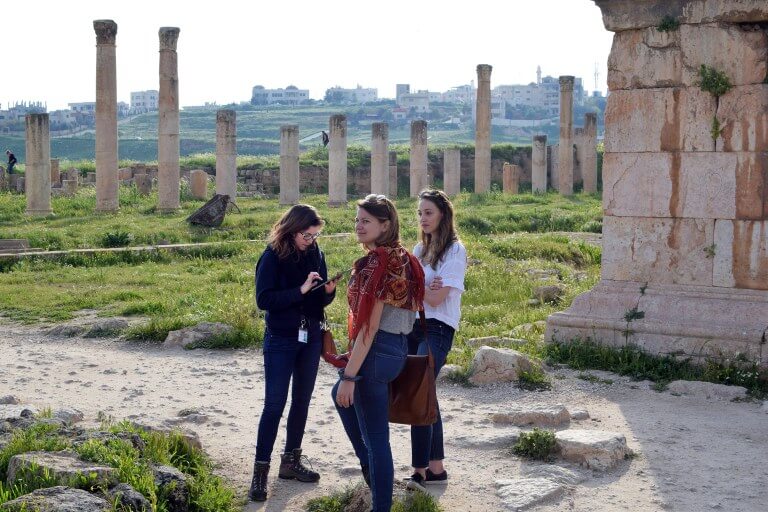
Evelyn Hill during an interview near the temple of Artemis
When
The duration of the visitor study was set from April 4th to May 15th 2019 in order to capture tourism high season at the site. The interviews were distributed across the days of the week in order to have more than one third collected during weekend days (Friday and Saturday).
Demographics
From a demographic standpoint, the sample appears to be representative of a very diverse population. In terms of gender, the population is almost perfectly split between male and female (58.8% female, 41.2 % male).
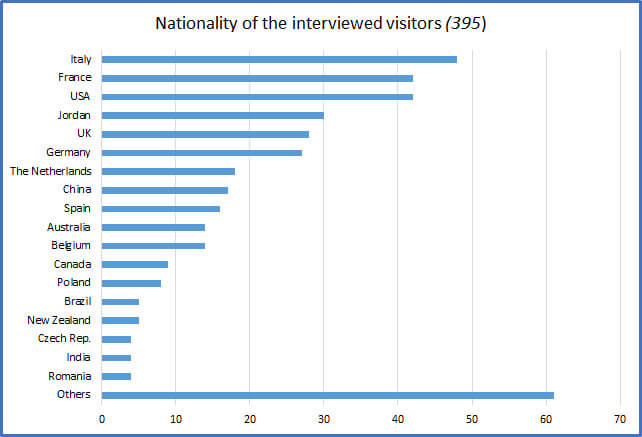
Fifty-one nationalities have been recorded. The main groups are Italian (12 % of the sample), American and French (both 11%), Jordanians (8%), followed by British, German, and Dutch. However, interviewees reside primarily in Jordan (11.4%) demonstrating that local tourism involves foreign residents. Only 2% of visitors come from neighboring countries such as UAE and Israel.
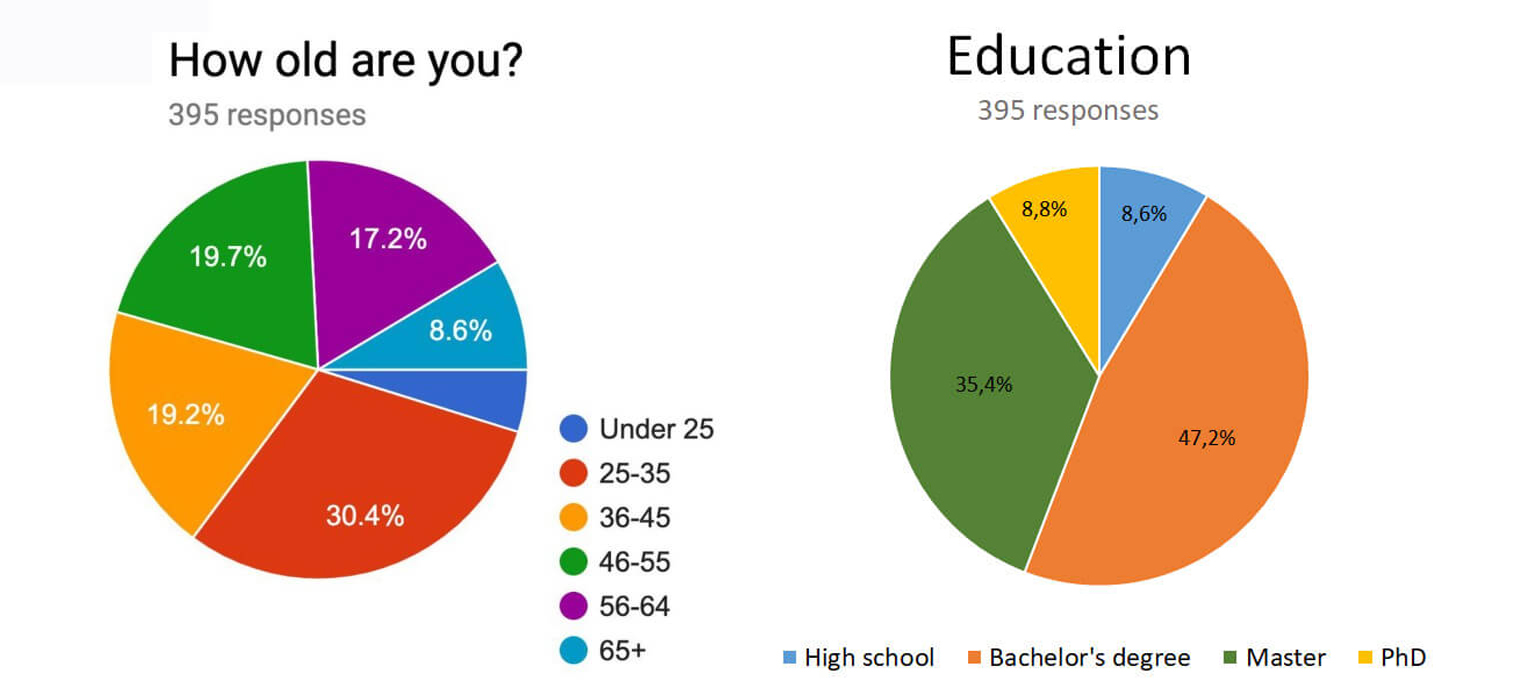
All age groups are represented, with 25-35 year-olds as almost a third of the sample. However, more than half is older than 45 years.Most of the sample (91.4%) has a degree, with almost half (44.2%) holding at least a Master’s.
Psychographics
Over 50% of those interviewed claimed that they travel abroad for tourism at least once or twice a year, while 31% travels abroad even more (3-5 times a year). In particular, 54% claim to visit more than 6 cultural sites in a year, and 31%, at least 3-5 sites a year.
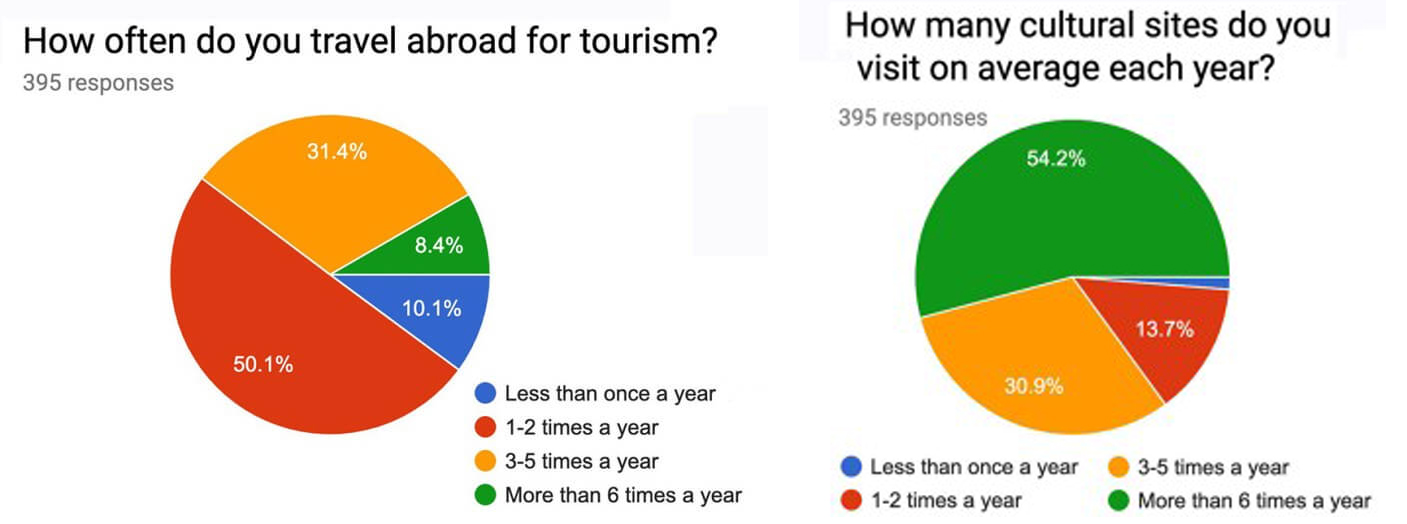
Most of the sample (58%) travels independently, while 20% prefers to rely on agencies and travel in organized groups. Importantly, in terms of behavior and services needed for tourists, to note that 13% of visitors travel with children.
The large majority of the population (89%) is not a member of any cultural organization.
Experience and behavior before leaving
When it came to how our sample learned of visiting Jerash, books and articles are still the main source (26% of the sample), followed by referrals from friends and family and web sources (both 21%), and lastly tour companies (16%).
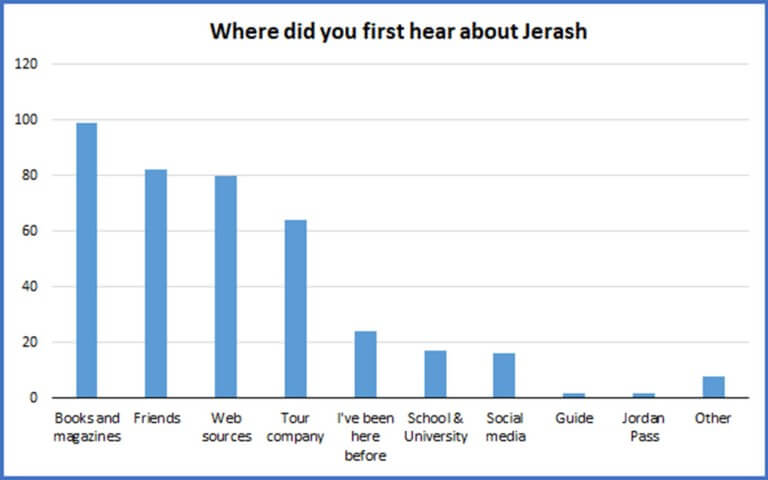
It is important to note that only 4% found out about Jerash from social media, which might be due to two main factors: the older age of the average respondent, with the older generation potentially more uncomfortable or unfamiliar with social media; and the lack of social media posts (from both official accounts and/or influencers) actively promoting the site.
Experience and behavior on site
When asked about the quality of their experience in Jerash, the sample claimed to be generally satisfied: over 95% of the population gave a positive response to the question, “How satisfied are you with your visit today?”
The reasons behind such a high level of satisfaction is related mostly to the scale of the site and the quality of ruins found there. Tourists generally cite specific monuments within Jerash to articulate their satisfaction with the experience.
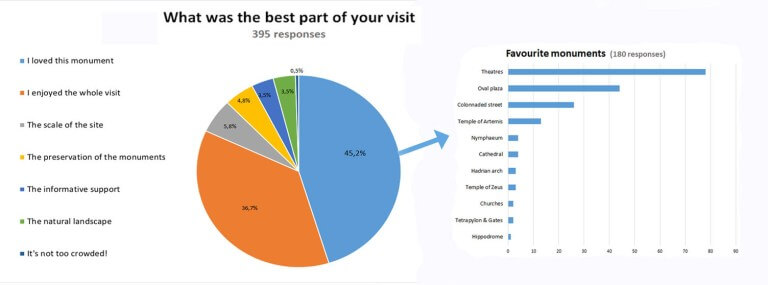
Dissatisfaction is instead due mostly to management aspects, such as the low level of maintenance (“The monuments look abandoned”) and cleanliness, followed by customer service and a lack of information provided to visitors.
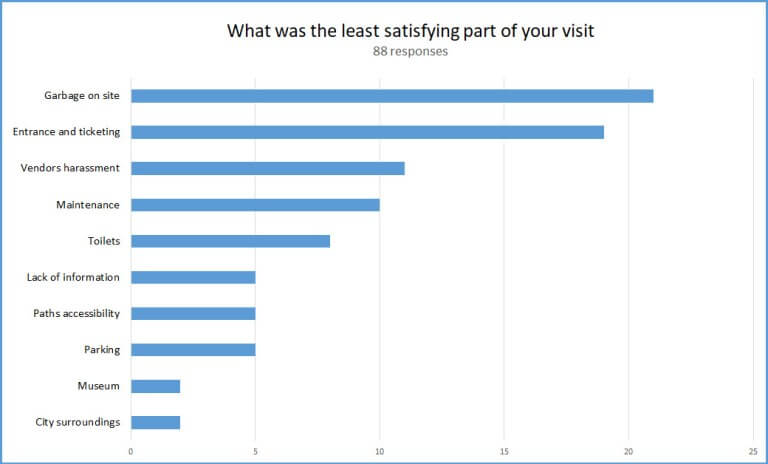
When asked what could make their visit better and more enjoyable, the majority claimed more information on site (signage and description), better facilities (particularly toilets) would be a main focus, followed by general maintenance of the site (removing vegetation and rubbish). Tourist pressure is also highlighted as an issue, which includes “harassment” by vendors prior to entry and while on site.
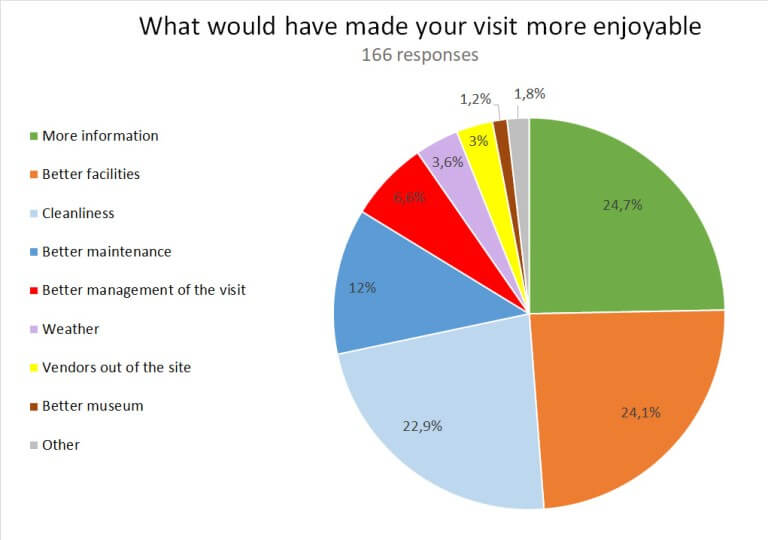
Respondents were also asked about their main reason for coming to Jerash. A large group said their main reason was that the site was included in their organized tour (24%), in line with the percentage of tourists traveling in a tour group. The other half of the sample, those traveling independently, reported a mix of reasons: they heard about the site while researching their trip to Jordan (59%); Jerash is close to Amman (39%); a strong passion for history and archaeology (25%); and they heard of Jerash while already in Jordan (16%). Notably, over 8% were there to show the site to friends and family.
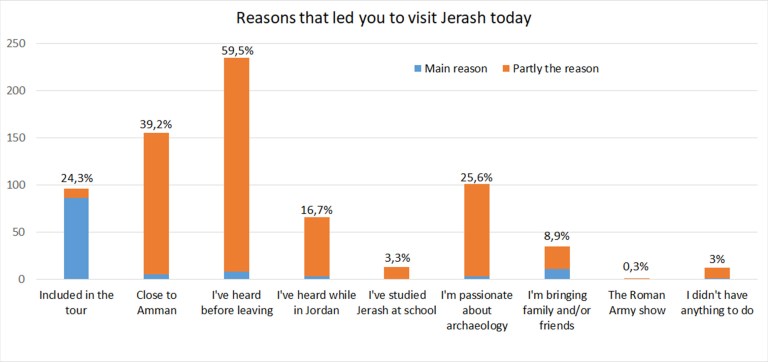
Such statistics are, however, in contrast to the fact that over 80% of those interviewed declared to be in Jordan for cultural tourism. Why is it, then, that so few of them were aware of the site before arriving in Jordan, considering Jerash is the second-most important cultural site in the country?
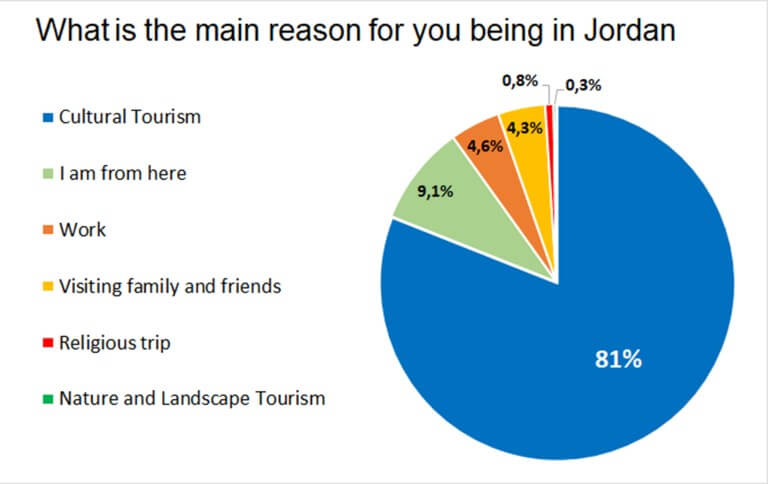
While there, the visitors interviewed used mostly brochures and posted signage to navigate the site and claimed the materials were useful in their understanding of the history of Jerash. Many also made use of guided tours and their own guide books (mostly Lonely Planet and Rough Guide). Few used digital sources during their visit, likely due to poor wireless internet service in the area and a lack of WiFi hotspots.
Even fewer visitors utilized a local guide, a missed opportunity for the local economy.
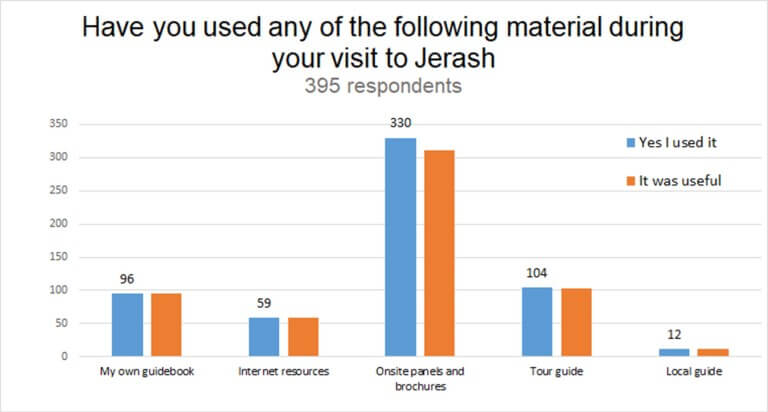
Added on top of all these tendencies was another missed opportunity: nearly the entire sample (93%) was in Jerash for only half a day, adding virtually nothing to the local economy.
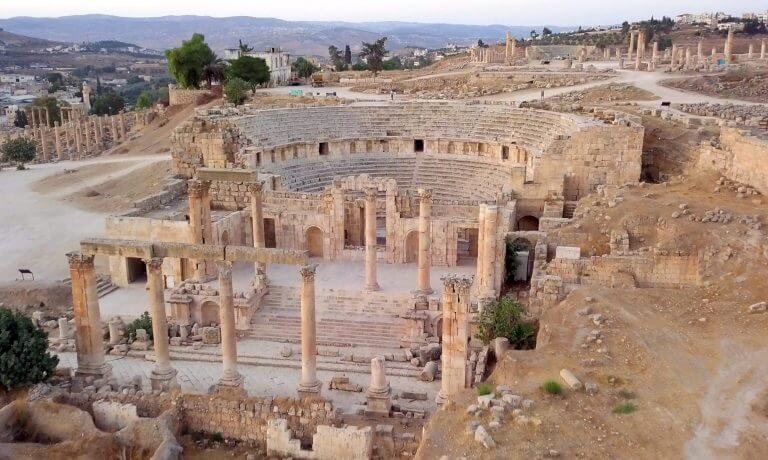
The North Theatre (photo C. Boyd). The two theaters are the most appreciated monuments in the site.
Some preliminary observations
The goal of the study is to provide an overview of public perception and the experience of the average visitor to Jerash, in order to create a base for developing further strategies and activities of cultural marketing, promotion, and interpretation.
The demographic profile highlights important opportunities for the management of tourists in Jerash. However, it also underscores the relative modesty of the Jordanian sample and the need for communications that stimulate the interest of less-educated visitors, starting with the citizens of Jerash themselves.
According to recent research conducted by the US Travel Association (2017) and Allianz Travel Insurance (2017), the average tourist identified in the Jerash Visitor Study falls in the category of the “big spender,” which could potentially be a great asset to the local economy of the city. Furthermore, the Allianz Travel Insurance Vacation Confidence Index (2017) reported that the generation aged 35-54 years spends an average of $2,628 on summer vacations, placing this age group at the top of the highest-spending age group among American travelers, a figure which is basically correlative to most European tourists.
Therefore, Jerash attracts a potentially positive “type” of tourist: the big-spending, well-travelled, culture lover who is well-educated and therefore potentially open to engagement in culturally-challenging experiences which the local community could economically and culturally benefit from.
This effect is not being seen today, and the reasons for this missed opportunity are clearly identifiable in the data collected through our investigation.
The way this average group “consumes” the site, that is the way in which they experience it personally and have an opportunity to spend money while there, has an impact. One could say that they come, they see, and then they leave within a few hours. They don’t engage with local businesses (which are generally considered as “harassment”). Although they have a limited experience of the area they still have a high potential to attract new visitors, becoming “influencers” back home, a capacity that is going untapped. On average, visitors themselves do not create exponentially more visitors. One reason might be that the only marketing efforts done to attract this target audience is conducted by (mostly international) tourist agencies, which rightly have their own agenda.
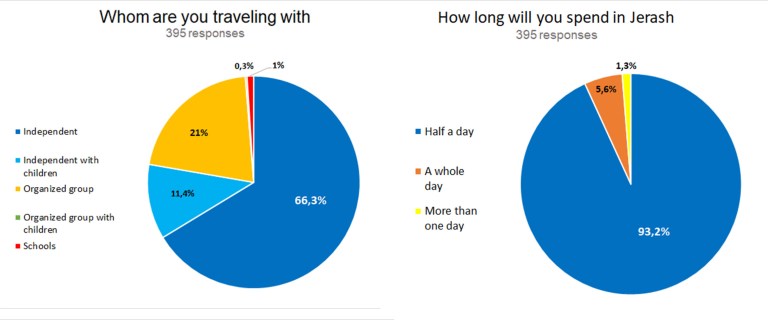
Our main recommendations are:
– Examine in-depth the packages offered by tourist agencies and their strategies, with the central aim being to maximize marketing efforts and encourage visitor retention within Jerash;
– Improve services on site in order to provide a more positive experience to potential “influencers” and “brand ambassadors”;
– Identify assets for the retention of tourists and draft a strategy in collaboration with local vendors to transform the feeling of “harassment” into a more welcoming environment;
– Examine in-depth the potential needs and interests of younger populations and families with children. Even though the site naturally attracts a potentially “good” type of tourist, it is critical to diversify the market and attract and entertain the groups that are underrepresented at the moment. This is a critical investment for the future as younger generations traveling on a budget today are the big spenders of tomorrow.
It has been proven that independent travelers contribute more to the local economy of visited places and put less pressure on cultural sites. It is therefore critical to the future of the site to encourage this style of traveling, both in Jerash and Jordan at large, by making sure all necessary information for arranging trips is available, both prior to and during the trip itself, in order to capture a wider market. In order to do so, it is necessary to draft a proper marketing and communication strategy based on the initial data collected through this study and to identify the main partners who might support and contribute to the strategy. It is critical that the average tourist feels safe around the site and has realistic expectations for their experience.
Jerash is one of the main cultural site of Jordan, however there is still a lack of general awareness of its existence. Beyond improving a proper individual marketing strategy, as suggested above, one idea could be to partner with other cultural organizations and/or nearby sites in a kind of network that could offer support in promotion and marketing efforts.
Clearly, it is fundamental that once on site both monuments and customer experience are world-class. There is no need to be technologically advanced to enjoy Jerash; however, visitor options should be in line with international standards and expectations. A difficult challenge will be organizing the on-site staff of the Department of Antiquities, and enhancing their admittedly limited resources available; but while difficult, this is clearly necessary. The conservation project in the Temple of Artemis is one example of evolving practices, as it involves professional training of the staff in charge of the daily maintenance of monuments, transferring experience and know-how of conservative techniques. Hopefully over time, our project, and others like it, will have a positive impact on the general condition of the monuments, enhancing their uniqueness in the eyes of visitors.
August 2019
***
The Jordanian Minister of Tourism and Antiquities declared in 2019 a goal to increase the number of tourists in Jordan from about 4 million to 7 million by 2020, with the objective being to double the contribution of tourism to national GDP by 2022 (from 12% to 24%).
Given what has been recorded in Jerash, this was a reasonable target: from 2015 to 2018, the number of tickets sold annually at the site increased from 179,000 to 260,000. In December 2019, unofficial information from the Department of Antiquities reported almost double the number of visitors compared with the previous year.
The recent closure of the archaeological site due to Covid-19, and the global consequences of the pandemic on the international tourism industry, has thwarted the efforts of the Ministry to pursue this goal. Again, like the miserable consequences on tourism of 9/11 and the Al-Aqsa Intifada, Jordan is seemingly called once again to climb the Sisyphean hill of re-establishing international tourist inflows, and recreate the gains of recent years. Nonetheless, this appalling situation is a rare opportunity to take advantage of a forced pause to rethink and reorganize site maintenance and the management of touristic resources, and also collaborate with the city council to enhance the benefits of the archaeological area among the citizens of Jerash.
June 2020
Would be interested in knowing more about the research do not hesitate to get in touch!
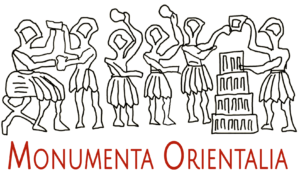
Countries
